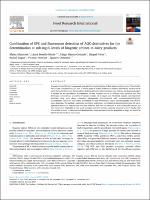Por favor, use este identificador para citar o enlazar este ítem:
https://repositorio.usj.es/handle/123456789/1007
| Título : | Combination of SPE and fluorescent detection of AQC-derivatives for the determination at sub-mg/L levels of biogenic amines in dairy products |
| Autor: | Moniente, Marta


Botello-Morte, Laura 


García-Gonzalo, Diego 


Virto, Raquel 
Pagán Tomás, Rafael 


Ferreira, Vicente 


Ontañón, Ignacio 


|
| Palabras clave : | Histamine; Tyramine; Putrescine; Cadaverine; Dairy products; HPLC; AQC; Biogenic amines |
| Fecha de publicación: | 3-ene-2023 |
| Editorial : | Elsevier |
| Citación : | Marta Moniente, Laura Botello-Morte, Diego García-Gonzalo, Raquel Virto, Rafael Pagán, Vicente Ferreira, Ignacio Ontañón, Combination of SPE and fluorescent detection of AQC-derivatives for the determination at sub-mg/L levels of biogenic amines in dairy products, Food Research International,Volume 165,2023,112448,ISSN 0963-9969,https://doi.org/10.1016/j.foodres.2022.112448. |
| Resumen : | Biogenic amines (BAs) are compounds generated by decarboxylation of their amino acid precursors. Their intake, even at low concentrations, can lead to several types of health problems in sensitive individuals. As they can be easily formed in fermented dairy products, their quantitative determination is very relevant. In the present paper, a method for the quantitative determination of four biogenic amines in different dairy products has been developed, validated and applied to 37 samples of milk, 23 of yogurt, and 14 of kefir. Amines were selectively extracted using solid phase extraction, subsequently derivatizatized with 6-aminoquinolyl-N-hydroxysuccinimidyl carbamate and further determined by High Performance Liquid Chromatography with fluorescence detection. The method’s sensitivity was highly satisfactory, with limits of detection lower than 0.2 mg/L. Optimal linearity and repeatability were also achieved. BAs were not detected in most of the milk samples, but they were found frequently at high levels in yogurt and kefir samples, reaching values of up to 79 mg/kg total BAs in kefir samples. Levels measured should not be a cause for concern for the population at large, but should be known by BAs-sensitive individuals. |
| URI : | https://repositorio.usj.es/handle/123456789/1007 |
| ISSN : | 0963-9969 |
| Aparece en las colecciones: | Artículos de revistas |
Ficheros en este ítem:
| Fichero | Descripción | Tamaño | Formato | |
|---|---|---|---|---|
| Combination of SPE and fluorescent detection.pdf | 1,6 MB | Adobe PDF |  Visualizar/Abrir |
Este ítem está sujeto a una licencia Creative Commons Licencia Creative Commons

